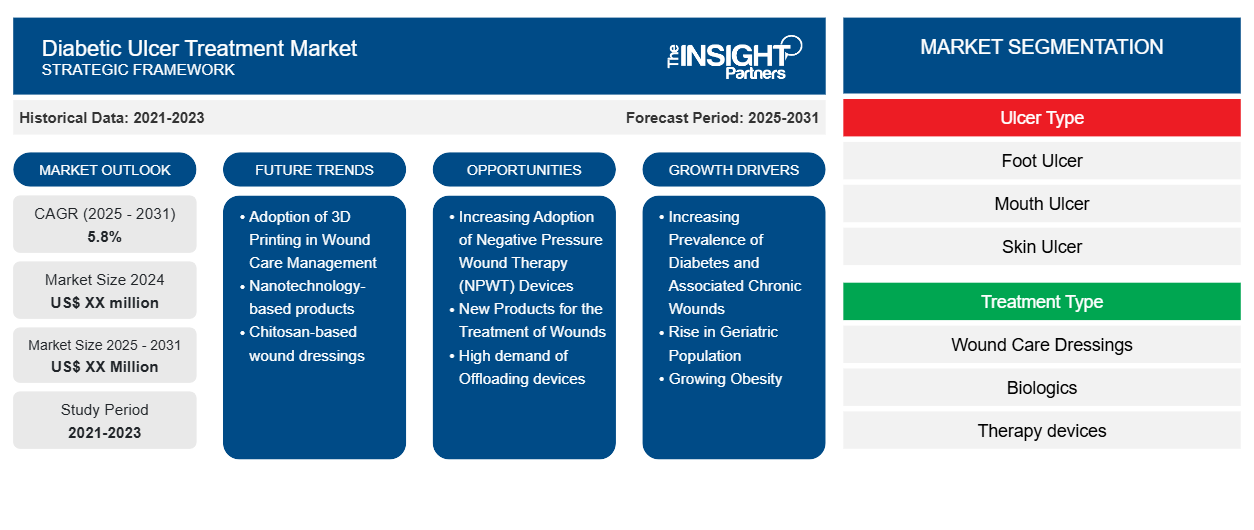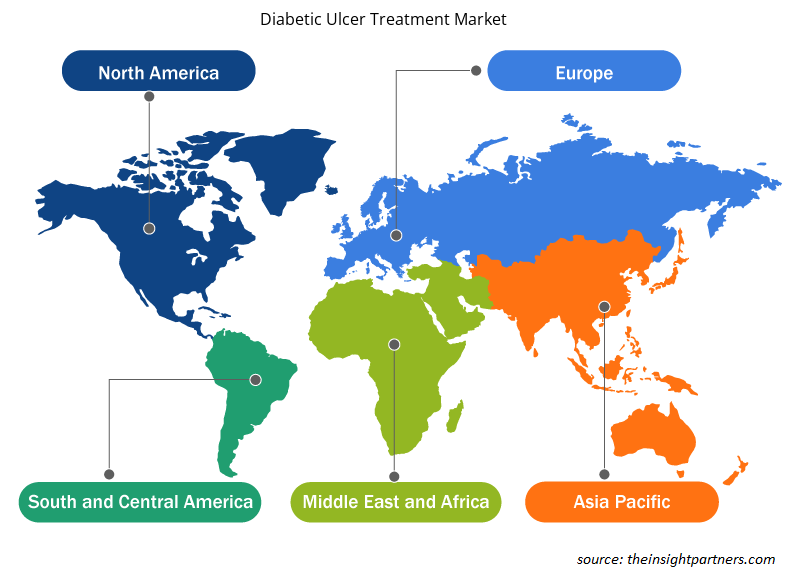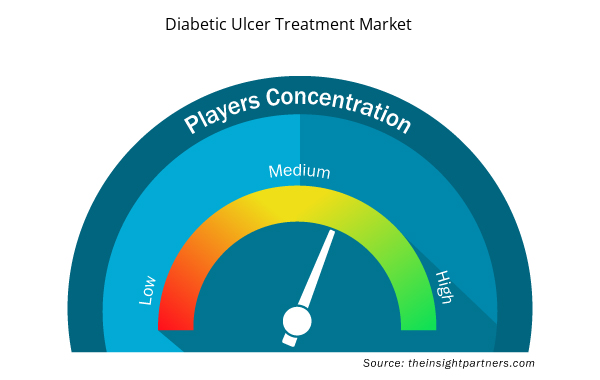Le marché du traitement des ulcères diabétiques devrait enregistrer un TCAC de 5,8 % de 2025 à 2031, avec une taille de marché passant de XX millions USD en 2024 à XX millions USD d'ici 2031.
Le rapport est segmenté par type d'ulcère (ulcère du pied, ulcère buccal, ulcère cutané, ulcère cornéen, autres) et par type de traitement (pansements, produits biologiques, dispositifs thérapeutiques). Il présente également une analyse par utilisateur final (hôpitaux, centres de chirurgie ambulatoire, soins à domicile, centres de santé communautaires). L'analyse globale est ensuite ventilée par région et par pays. Le rapport présente la valeur en USD pour l'analyse et les segments ci-dessus.
Objet du rapport
Le rapport sur le marché du traitement des ulcères diabétiques, publié par The Insight Partners, vise à décrire le paysage actuel et la croissance future, les principaux moteurs, les défis et les opportunités. Il fournira des informations aux différents acteurs du secteur, notamment :
- Fournisseurs/fabricants de technologies : pour comprendre l’évolution de la dynamique du marché et connaître les opportunités de croissance potentielles, leur permettant de prendre des décisions stratégiques éclairées.
- Investisseurs : réaliser une analyse complète des tendances concernant le taux de croissance du marché, les projections financières du marché et les opportunités qui existent tout au long de la chaîne de valeur.
- Organismes de réglementation : Réglementer les politiques et les activités de police sur le marché dans le but de minimiser les abus, de préserver la confiance des investisseurs et de maintenir l’intégrité et la stabilité du marché.
Segmentation du marché du traitement des ulcères diabétiques
Type d'ulcère
- Ulcère du pied
- Ulcère de la bouche
- Ulcère cutané
- Ulcère cornéen
- Autres
Type de traitement
- Pansements pour le soin des plaies
- Produits biologiques
- Appareils de thérapie
Utilisateur final
- Hôpitaux
- Centres de chirurgie ambulatoire
- Soins à domicile
- Centres de santé communautaires
Géographie
- Amérique du Nord
- Europe
- Asie-Pacifique
- Amérique du Sud et Amérique centrale
- Moyen-Orient et Afrique
Personnalisez ce rapport en fonction de vos besoins
Vous bénéficierez d'une personnalisation gratuite de n'importe quel rapport, y compris des parties de ce rapport, ou d'une analyse au niveau des pays, d'un pack de données Excel, ainsi que de superbes offres et réductions pour les start-ups et les universités.
Marché du traitement des ulcères diabétiques : perspectives stratégiques

- Obtenez les principales tendances clés du marché de ce rapport.Cet échantillon GRATUIT comprendra une analyse de données, allant des tendances du marché aux estimations et prévisions.
Facteurs de croissance du marché du traitement des ulcères diabétiques
- Prévalence croissante du diabète et des plaies chroniques associées :
les plaies peuvent être classées en aiguës et chroniques, selon leur temps de cicatrisation. Le diabète est l'une des urgences sanitaires les plus graves au monde au XXIe siècle. Selon l'American Heart Association, Inc., en 2024, environ 29,3 millions de personnes aux États-Unis ont reçu un diagnostic de diabète, et la population diabétique représente environ 10,5 % de la population totale du pays. - Augmentation de la population gériatrique :
La population âgée est définie comme le groupe des personnes âgées de 65 ans et plus. Le vieillissement est l’une des transformations sociales les plus importantes du XXIe siècle. Le vieillissement de la population est un problème particulièrement observé dans les Amériques, en Europe et en Asie-Pacifique. Selon les données de l’UNFPA, la proportion de personnes âgées de 65 ans ou plus dans le monde a presque doublé, passant de 5,5 % en 1974 à 10,3 % en 2024. - Obésité croissante :
L’obésité est liée au diabète. L’excès de masse grasse entraîne le diabète de type 2, qui favorise également le développement d’ulcères diabétiques. Selon l’Organisation mondiale de la Santé (OMS), en 2022, une personne sur huit, soit 890 personnes dans le monde, souffrait d’obésité. Cette tendance devrait se poursuivre, avec une augmentation prévue de 35 % de l’obésité à l’échelle mondiale d’ici 2030.
Tendances futures du marché du traitement des ulcères diabétiques
- Adoption de l'impression 3D dans la gestion des plaies : Les plaies causées par diverses maladies liées au diabète représentent un fardeau considérable pour les systèmes de santé du monde entier. De nombreux groupes de recherche et entreprises envisagent l'impression 3D comme nouveau traitement des plaies liées au diabète. Par exemple, des chercheurs de l'Université de Californie à San Diego mènent des recherches sur le développement d'échafaudages imprimés en 3D à partir de matériaux chargés de molécules bioactives favorisant la cicatrisation des plaies.
- Produits issus des nanotechnologies : La recherche sur les nanotechnologies, et notamment sur les nanofibrous scaffolds (NFS), connaît un essor rapide et a eu un impact positif sur le traitement des plaies diabétiques. Parmi les traitements adjuvants, les nanofibrous scaffolds (NFS) constituent une alternative pertinente, offrant un potentiel supérieur à celui de tout autre complément aux médicaments essentiels pour accélérer la cicatrisation.
- Pansements à base de chitosane : Le chitosane est un polymère naturel bien étudié, largement utilisé dans les applications biomédicales en raison de son action antiseptique et de sa capacité à faciliter la cicatrisation. Il favorise le drainage et prévient l'accumulation d'exsudats ; de plus, le chitosane agit comme un lit d'autogreffe dans le traitement des plaies. La popularité croissante des pansements à base de chitosane est l'une des principales tendances observées dans les pays développés.
Opportunités de marché pour le traitement des ulcères diabétiques
- Adoption croissante des dispositifs de traitement des plaies par pression négative (TPN) : Il a été cliniquement prouvé que les dispositifs de TPN cicatrisent les plaies et réduisent le risque de complications liées aux ulcères diabétiques. Cependant, leur adoption reste difficile en raison de leur coût et de leur complexité d'utilisation. L'évolution constante des technologies offre aux entreprises l'opportunité de proposer des dispositifs de TPN plus abordables et conviviaux, capables d'accélérer leur adoption et de conquérir le marché.
- Nouveaux produits pour le traitement des plaies : Le développement de nouveaux produits pour le traitement des plaies, capables d'accélérer la guérison et de réduire le risque de complications liées aux ulcères diabétiques, offre des perspectives d'application prometteuses. Ces produits pourraient inclure, entre autres, des nanomatériaux, des molécules bioactives et des surfaces biomimétiques. Ils offrent un avantage en termes d'efficacité et de résultats pour les patients. Les nouveaux produits pour le traitement des plaies pourraient trouver une part de marché significative pour les entreprises qui investissent dans la recherche et le développement.
- Forte demande de dispositifs de décharge : ces dispositifs sont conçus pour réduire la pression et soulager l'inconfort causé par un ulcère diabétique. Face à l'augmentation du nombre de cas de diabète dans le monde, la demande de dispositifs de décharge est forte, notamment dans les régions sous-développées. Les entreprises qui investissent dans la R&D pour développer des dispositifs de décharge innovants en tireront de nombreux avantages.
Aperçu régional du marché du traitement des ulcères diabétiques
Les tendances et facteurs régionaux influençant le marché du traitement de l'ulcère diabétique tout au long de la période de prévision ont été analysés en détail par les analystes d'Insight Partners. Cette section aborde également les segments et la géographie du marché du traitement de l'ulcère diabétique en Amérique du Nord, en Europe, en Asie-Pacifique, au Moyen-Orient et en Afrique, ainsi qu'en Amérique du Sud et en Amérique centrale.

- Obtenez les données régionales spécifiques au marché du traitement des ulcères diabétiques
Portée du rapport sur le marché du traitement des ulcères diabétiques
| Attribut de rapport | Détails |
|---|---|
| Taille du marché en 2024 | XX millions de dollars américains |
| Taille du marché d'ici 2031 | XX millions de dollars américains |
| TCAC mondial (2025 - 2031) | 5,8% |
| Données historiques | 2021-2023 |
| Période de prévision | 2025-2031 |
| Segments couverts | Par type d'ulcère
|
| Régions et pays couverts | Amérique du Nord
|
| Leaders du marché et profils d'entreprises clés |
|
Densité des acteurs du marché du traitement des ulcères diabétiques : comprendre son impact sur la dynamique commerciale
Le marché du traitement de l'ulcère diabétique connaît une croissance rapide, portée par une demande croissante des utilisateurs finaux, due à des facteurs tels que l'évolution des préférences des consommateurs, les avancées technologiques et une meilleure connaissance des avantages du produit. Face à cette demande croissante, les entreprises élargissent leur offre, innovent pour répondre aux besoins des consommateurs et capitalisent sur les nouvelles tendances, ce qui alimente la croissance du marché.
La densité des acteurs du marché désigne la répartition des entreprises opérant sur un marché ou un secteur particulier. Elle indique le nombre de concurrents (acteurs) présents sur un marché donné par rapport à sa taille ou à sa valeur marchande totale.
Les principales entreprises opérant sur le marché du traitement des ulcères diabétiques sont :
- ConvaTec, Inc.
- Acelity LP Inc.
- 3M
- Coloplast A/S
- Smith & Nephew Plc.
Avertissement : Les entreprises répertoriées ci-dessus ne sont pas classées dans un ordre particulier.

- Obtenez un aperçu des principaux acteurs du marché du traitement des ulcères diabétiques
Principaux arguments de vente
- Couverture complète : Le rapport couvre de manière exhaustive l’analyse des produits, des services, des types et des utilisateurs finaux du marché du traitement des ulcères diabétiques, offrant un paysage holistique.
- Analyse d’experts : Le rapport est compilé sur la base d’une compréhension approfondie des experts et analystes du secteur.
- Informations à jour : Le rapport garantit la pertinence commerciale en raison de sa couverture des informations récentes et des tendances des données.
- Options de personnalisation : ce rapport peut être personnalisé pour répondre aux exigences spécifiques des clients et s'adapter de manière appropriée aux stratégies commerciales.
Le rapport de recherche sur le marché du traitement des ulcères diabétiques peut donc contribuer à décrypter et à comprendre le contexte et les perspectives de croissance du secteur. Malgré quelques inquiétudes légitimes, les avantages globaux de ce rapport tendent à l'emporter sur ses inconvénients.
- Analyse historique (2 ans), année de base, prévision (7 ans) avec TCAC
- Analyse PEST et SWO
- Taille du marché Valeur / Volume - Mondial, Régional, Pays
- Industrie et paysage concurrentiel
- Ensemble de données Excel


- Biopharmaceutical Contract Manufacturing Market
- Cosmetic Bioactive Ingredients Market
- Aesthetic Medical Devices Market
- Molecular Diagnostics Market
- Educational Furniture Market
- Data Annotation Tools Market
- Non-Emergency Medical Transportation Market
- Sterilization Services Market
- Dropshipping Market
- Social Employee Recognition System Market

Report Coverage
Revenue forecast, Company Analysis, Industry landscape, Growth factors, and Trends

Segment Covered
This text is related
to segments covered.

Regional Scope
North America, Europe, Asia Pacific, Middle East & Africa, South & Central America

Country Scope
This text is related
to country scope.
Questions fréquemment posées
The diabetes ulcer treatment market is estimated to grow with a CAGR of 5.8% from 2023 to 2031
Asia-Pacific region is likely to witness the fastest growth rate during the forecast period.
The market drivers include the increasing prevalence of diabetes and rising geriatric population, which are driving the diabetes ulcer treatment market
The diabetes ulcer treatment market majorly consists of players such as ConvaTec, Smith & Nephew Plc, B. Braun Melsungen AG among others.
Nanotechnology-based products is likely to remain the key trend during the forecast period.
North America dominated the diabetic ulcer treatment market in 2023
Trends and growth analysis reports related to Life Sciences : READ MORE..
1. ConvaTec, Inc.2. Acelity L.P. Inc.3. 3M4. Coloplast A/S5. Smith & Nephew Plc.6. B. Braun Melsungen AG7. Medline Industries, Inc.8. Medtronic Plc.9. Cardinal Health10. Molnlycke Health Care AB
The Insight Partners performs research in 4 major stages: Data Collection & Secondary Research, Primary Research, Data Analysis and Data Triangulation & Final Review.
- Data Collection and Secondary Research:
As a market research and consulting firm operating from a decade, we have published and advised several client across the globe. First step for any study will start with an assessment of currently available data and insights from existing reports. Further, historical and current market information is collected from Investor Presentations, Annual Reports, SEC Filings, etc., and other information related to company’s performance and market positioning are gathered from Paid Databases (Factiva, Hoovers, and Reuters) and various other publications available in public domain.
Several associations trade associates, technical forums, institutes, societies and organization are accessed to gain technical as well as market related insights through their publications such as research papers, blogs and press releases related to the studies are referred to get cues about the market. Further, white papers, journals, magazines, and other news articles published in last 3 years are scrutinized and analyzed to understand the current market trends.
- Primary Research:
The primarily interview analysis comprise of data obtained from industry participants interview and answers to survey questions gathered by in-house primary team.
For primary research, interviews are conducted with industry experts/CEOs/Marketing Managers/VPs/Subject Matter Experts from both demand and supply side to get a 360-degree view of the market. The primary team conducts several interviews based on the complexity of the markets to understand the various market trends and dynamics which makes research more credible and precise.
A typical research interview fulfils the following functions:
- Provides first-hand information on the market size, market trends, growth trends, competitive landscape, and outlook
- Validates and strengthens in-house secondary research findings
- Develops the analysis team’s expertise and market understanding
Primary research involves email interactions and telephone interviews for each market, category, segment, and sub-segment across geographies. The participants who typically take part in such a process include, but are not limited to:
- Industry participants: VPs, business development managers, market intelligence managers and national sales managers
- Outside experts: Valuation experts, research analysts and key opinion leaders specializing in the electronics and semiconductor industry.
Below is the breakup of our primary respondents by company, designation, and region:

Once we receive the confirmation from primary research sources or primary respondents, we finalize the base year market estimation and forecast the data as per the macroeconomic and microeconomic factors assessed during data collection.
- Data Analysis:
Once data is validated through both secondary as well as primary respondents, we finalize the market estimations by hypothesis formulation and factor analysis at regional and country level.
- Macro-Economic Factor Analysis:
We analyse macroeconomic indicators such the gross domestic product (GDP), increase in the demand for goods and services across industries, technological advancement, regional economic growth, governmental policies, the influence of COVID-19, PEST analysis, and other aspects. This analysis aids in setting benchmarks for various nations/regions and approximating market splits. Additionally, the general trend of the aforementioned components aid in determining the market's development possibilities.
- Country Level Data:
Various factors that are especially aligned to the country are taken into account to determine the market size for a certain area and country, including the presence of vendors, such as headquarters and offices, the country's GDP, demand patterns, and industry growth. To comprehend the market dynamics for the nation, a number of growth variables, inhibitors, application areas, and current market trends are researched. The aforementioned elements aid in determining the country's overall market's growth potential.
- Company Profile:
The “Table of Contents” is formulated by listing and analyzing more than 25 - 30 companies operating in the market ecosystem across geographies. However, we profile only 10 companies as a standard practice in our syndicate reports. These 10 companies comprise leading, emerging, and regional players. Nonetheless, our analysis is not restricted to the 10 listed companies, we also analyze other companies present in the market to develop a holistic view and understand the prevailing trends. The “Company Profiles” section in the report covers key facts, business description, products & services, financial information, SWOT analysis, and key developments. The financial information presented is extracted from the annual reports and official documents of the publicly listed companies. Upon collecting the information for the sections of respective companies, we verify them via various primary sources and then compile the data in respective company profiles. The company level information helps us in deriving the base number as well as in forecasting the market size.
- Developing Base Number:
Aggregation of sales statistics (2020-2022) and macro-economic factor, and other secondary and primary research insights are utilized to arrive at base number and related market shares for 2022. The data gaps are identified in this step and relevant market data is analyzed, collected from paid primary interviews or databases. On finalizing the base year market size, forecasts are developed on the basis of macro-economic, industry and market growth factors and company level analysis.
- Data Triangulation and Final Review:
The market findings and base year market size calculations are validated from supply as well as demand side. Demand side validations are based on macro-economic factor analysis and benchmarks for respective regions and countries. In case of supply side validations, revenues of major companies are estimated (in case not available) based on industry benchmark, approximate number of employees, product portfolio, and primary interviews revenues are gathered. Further revenue from target product/service segment is assessed to avoid overshooting of market statistics. In case of heavy deviations between supply and demand side values, all thes steps are repeated to achieve synchronization.
We follow an iterative model, wherein we share our research findings with Subject Matter Experts (SME’s) and Key Opinion Leaders (KOLs) until consensus view of the market is not formulated – this model negates any drastic deviation in the opinions of experts. Only validated and universally acceptable research findings are quoted in our reports.
We have important check points that we use to validate our research findings – which we call – data triangulation, where we validate the information, we generate from secondary sources with primary interviews and then we re-validate with our internal data bases and Subject matter experts. This comprehensive model enables us to deliver high quality, reliable data in shortest possible time.

 Obtenez un échantillon gratuit pour ce rapport
Obtenez un échantillon gratuit pour ce rapport